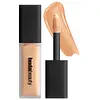What's inside
What's inside
 Key Ingredients
Key Ingredients

 Benefits
Benefits

 Concerns
Concerns

 Ingredients Side-by-side
Ingredients Side-by-side

Cyclopentasiloxane
EmollientWater
Skin ConditioningTrimethylsiloxysilicate
EmollientButylene Glycol
HumectantPEG/PPG-18/18 Dimethicone
EmulsifyingGlycerin
HumectantPolymethylsilsesquioxane
Disteardimonium Hectorite
Stabilising1,2-Hexanediol
Skin ConditioningSorbitan Sesquioleate
EmulsifyingMagnesium Sulfate
Cyclohexasiloxane
EmollientTribehenin
EmollientTocopheryl Acetate
AntioxidantAluminum Hydroxide
EmollientPropylene Carbonate
SolventHydrogen Dimethicone
Butyrospermum Parkii Butter
Skin ConditioningCaprylyl Glycol
EmollientEthylhexylglycerin
Skin ConditioningParfum
MaskingCellulose Gum
Emulsion StabilisingXanthan Gum
EmulsifyingDimethicone
EmollientTriethoxycaprylylsilane
Phytosphingosine
Skin ConditioningPalmitoyl Tripeptide-5
Skin ConditioningIron Oxides
Titanium Dioxide
Cosmetic ColorantMica
Cosmetic ColorantCyclopentasiloxane, Water, Trimethylsiloxysilicate, Butylene Glycol, PEG/PPG-18/18 Dimethicone, Glycerin, Polymethylsilsesquioxane, Disteardimonium Hectorite, 1,2-Hexanediol, Sorbitan Sesquioleate, Magnesium Sulfate, Cyclohexasiloxane, Tribehenin, Tocopheryl Acetate, Aluminum Hydroxide, Propylene Carbonate, Hydrogen Dimethicone, Butyrospermum Parkii Butter, Caprylyl Glycol, Ethylhexylglycerin, Parfum, Cellulose Gum, Xanthan Gum, Dimethicone, Triethoxycaprylylsilane, Phytosphingosine, Palmitoyl Tripeptide-5, Iron Oxides, Titanium Dioxide, Mica
Water
Skin ConditioningCyclopentasiloxane
EmollientPropanediol
SolventDimethicone
EmollientPhenyl Trimethicone
Skin ConditioningTrimethylsiloxysilicate
EmollientLauryl PEG-9 Polydimethylsiloxyethyl Dimethicone
Skin ConditioningPhenylisopropyl Dimethicone
Skin ConditioningCaprylyl Methicone
Skin ConditioningHdi/Trimethylol Hexyllactone Crosspolymer
C20-24 Alkyl Dimethicone
Skin ConditioningSynthetic Fluorphlogopite
Prunus Amygdalus Dulcis Oil
Skin ConditioningTocopherol
AntioxidantTocopheryl Acetate
AntioxidantEthylhexylglycerin
Skin ConditioningSodium Chloride
MaskingAluminum Hydroxide
EmollientHydrogen Dimethicone
Isododecane
EmollientTalc
AbrasiveDimethicone Crosspolymer
Emulsion StabilisingSodium Gluconate
Skin ConditioningDimethicone/PEG-10/15 Crosspolymer
Disteardimonium Hectorite
StabilisingSilica
AbrasiveTin Oxide
AbrasivePhenoxyethanol
PreservativeCI 77491
Cosmetic ColorantCI 77492
Cosmetic ColorantCI 77499
Cosmetic ColorantCI 77891
Cosmetic ColorantWater, Cyclopentasiloxane, Propanediol, Dimethicone, Phenyl Trimethicone, Trimethylsiloxysilicate, Lauryl PEG-9 Polydimethylsiloxyethyl Dimethicone, Phenylisopropyl Dimethicone, Caprylyl Methicone, Hdi/Trimethylol Hexyllactone Crosspolymer, C20-24 Alkyl Dimethicone, Synthetic Fluorphlogopite, Prunus Amygdalus Dulcis Oil, Tocopherol, Tocopheryl Acetate, Ethylhexylglycerin, Sodium Chloride, Aluminum Hydroxide, Hydrogen Dimethicone, Isododecane, Talc, Dimethicone Crosspolymer, Sodium Gluconate, Dimethicone/PEG-10/15 Crosspolymer, Disteardimonium Hectorite, Silica, Tin Oxide, Phenoxyethanol, CI 77491, CI 77492, CI 77499, CI 77891
 Reviews
Reviews

Ingredients Explained
These ingredients are found in both products.
Ingredients higher up in an ingredient list are typically present in a larger amount.
Aluminum Hydroxide is a form of aluminum. It can be naturally found in nature as the mineral gibbsite. In cosmetics, Aluminum Hydroxide is used as a colorant, pH adjuster, and absorbent.
As a colorant, Aluminum Hydroxide may add opacity, or reduce the transparency. Aluminum hydroxide is contains both basic and acidic properties.
According to manufacturers, this ingredient is an emollient and humectant. This means it helps hydrate the skin.
In medicine, this ingredient is used to help relieve heartburn and help heal ulcers.
There is currently no credible scientific evidence linking aluminum hydroxide in cosmetics to increased cancer risk.
Major health organizations allow the use of aluminum hydroxide in personal care products and have not flagged it as a carcinogenic risk at typical usage levels.
Learn more about Aluminum HydroxideCyclopentasiloxane, or D5, is a silicone used to improve texture of products and trap moisture.
D5 is considered lightweight and volatile. Volatile means it evaporates quickly after application. Once evaporated, D5 leaves a thin barrier that helps keep skin hydrated.
It is also an emollient. Emollients help soften the skin and prevent water loss. Silicones create a silky texture in products. D5 helps other ingredients become more spreadable.
Studies show D5 is safe to use in skincare products. We recommend speaking with a skincare professional if you have concerns.
Learn more about CyclopentasiloxaneDimethicone is a type of synthetic silicone created from natural materials such as quartz.
What it does:
Dimethicone comes in different viscosities:
Depending on the viscosity, dimethicone has different properties.
Ingredients lists don't always show which type is used, so we recommend reaching out to the brand if you have questions about the viscosity.
This ingredient is unlikely to cause irritation because it does not get absorbed into skin. However, people with silicone allergies should be careful about using this ingredient.
Note: Dimethicone may contribute to pilling. This is because it is not oil or water soluble, so pilling may occur when layered with products. When mixed with heavy oils in a formula, the outcome is also quite greasy.
Learn more about DimethiconeDisteardimonium Hectorite comes from the clay mineral named hectorite. It is used to add thickness to a product.
It can also help stabilize a product by helping to disperse other ingredients.
Hectorite is a rare, white clay mineral.
Learn more about Disteardimonium HectoriteEthylhexylglycerin (we can't pronounce this either) is commonly used as a preservative and skin softener. It is derived from glyceryl.
You might see Ethylhexylglycerin often paired with other preservatives such as phenoxyethanol. Ethylhexylglycerin has been found to increase the effectiveness of these other preservatives.
Hydrogen Dimethicone is a type of silicone.
Tocopheryl Acetate is AKA Vitamin E. It is an antioxidant and protects your skin from free radicals. Free radicals damage the skin by breaking down collagen.
One study found using Tocopheryl Acetate with Vitamin C decreased the number of sunburned cells.
Tocopheryl Acetate is commonly found in both skincare and dietary supplements.
Learn more about Tocopheryl AcetateThis silicone is an emollient. Emollients create a thin film on the skin to prevent moisture from escaping.
It is not soluble in water and helps increase water-resistance in products.
According to a manufacturer, it can blend seamlessly with silicone oils, such as Cyclopentasiloxane.
Learn more about TrimethylsiloxysilicateWater. It's the most common cosmetic ingredient of all. You'll usually see it at the top of ingredient lists, meaning that it makes up the largest part of the product.
So why is it so popular? Water most often acts as a solvent - this means that it helps dissolve other ingredients into the formulation.
You'll also recognize water as that liquid we all need to stay alive. If you see this, drink a glass of water. Stay hydrated!
Learn more about Water